When the USS Texas (BB-35) was commissioned on March 12, 1914, she was considered the most powerful ship on the seas. The first American battleship commissioned with 14-inch main guns, she boasted 10 in five turrets of two. Battleships continued the naval tradition of “ships of the line,” their name in fact being a shortened version of the term “line of battle ship.” The Texas, however, was never put to use against an enemy fleet as naval warfare evolved in the decades after her commissioning, rendering her obsolete for her intended purpose. But the Texas found new life in World War II, providing naval gunfire support for amphibious landings in three theaters. It was this new role that resulted in the only major damage and crew casualty inflicted by enemy forces in her 34 year service in the US Navy.
On June 6, 1944, Texas, commanded by Captain Charles A. Baker, had covered the Allied landings at Normandy, providing gunfire support primarily for the Rangers attempting to destroy enemy guns at Pointe du Hoc. In the week and a half which followed the invasion, she remained off Omaha beach, providing fire support, supplies, and medical assistance for troops ashore. After a week of minor repairs and replenishment in England, Texas left Portland on June 25 with Task Group 129.2. The task group was divided into two sections: Bombardment Group One, led by USS Nevada (BB-36), and Bombardment Group Two, which included Texas, USS Arkansas (BB-33), USS Barton (DD-722), USS O’Brien (DD-725), and USS Laffey (DD-724). The task force was to support the VII Corps drive on Cherbourg in three phases:
“Phase ONE: Commencing at H minus 30, engage enemy coastal batteries, using air spot, concentrating on long range heavy caliber installations that menace the approach of the Bombarding Forces.
Phase TWO: Commencing at H plus 50, engage medium coast batteries until neutralized.
Phase THREE: Deliver Support Fire as requested by units of Seventh Army Corps during advance on Cherbourg.”
H-Hour was set for 10:30 a.m. to ensure troops on the ground would be clear of any predesignated targets, but the exact locations of troops were too uncertain for VII Corps commander General Joe Collins to take a risk. Just three days before, a bombing mission carried out by Allied fighter-bombers had hit American lines, killing GIs. With this in mind, the mission was changed as the Task Group arrived in the fire support area off the French coast. At General Collins’ request, all prearranged firing was cancelled. Until noon, no ships were to fire on the coast unless first fired upon. After that, all ships were ordered to only provide support as requested by the VII Corps or to return fire if coastal batteries fired upon the group.
Initially, Nevada, with a main battery range of 34,000 yards (19 miles), was to neutralize Battery Hamburg, after which Texas and Arkansas were to finish the destruction. But with the change of orders from Collins, Nevada was busy on the western end of Cherbourg battling a battery there. Texas and Arkansas would have to engage Hamburg alone, and well within range. Situated six miles east of Cherbourg, Battery Hamburg was located on a hill near Fermanville. Manned by the German Kriegsmarine (navy), Hamburg was the most powerful German battery on the Cotentin Peninsula. Four, 280 mm (11-inch) guns were protected by reinforced concrete casemates. Widely spread out, they were surrounded by clusters of the infamous German 88 mm antiaircraft cannons and a dozen other antiaircraft guns. The 280 mm guns had a range of 40,000 yards (22.7 miles) compared to the maximum range of 23,000 yards (13 miles) of the 14-inch guns on Texas.
The remnants of one of Battery Hamburg’s massive gun emplacements. The guns are long since gone, and most of what remains is abandoned. The remnants of the battery are on private land, accessible only by permission. Photo by Kali Martin.
Just after 12 p.m. Arkansas made contact with its shore fire control party who requested the ship open fire on Battery Hamburg. Initially Hamburg did not respond, its crew waiting until the majority of the Bombardment Group came within range of their guns. Sailing westward from the east of Battery Hamburg, the Bombardment Group was outside of the arc of fire for the battery’s guns, which were positioned to fire predominately westward, covering the approach to Cherbourg harbor. Though Hamburg waited to return fire, the opening salvo from Arkansas lit off a three hour battle that grew from one ship and one shore battery to seven ships and numerous shore batteries.
Other coastal batteries opened fire along with Hamburg,and a salvo from a 240 mm gun landed among the destroyers, with Barton and Laffey each taking a hit from a dud. Texas was straddled by the third salvo from the shore, before turning her 14-inch guns on Hamburg with a two-gun salvo. Things began to heat up quickly, with fire exchanged on both sides at a rapid pace. Texas, taking a three-gun salvo across her stern, began to fire on a battery northeast of Hamburg. The O’Brien was hit by a round from Hamburg, which exploded in the combat information center, killing 13. With this third hit, the group was ordered to turn north and open the range with the shore batteries. Texas, with superior fire control and heavier main guns began her shootout with Hamburg.
Watching film footage of a battleship firing in no way gives you any clue to the true nature of the effect of a main battery salvo. Even one turret firing causes minor damage aboard a ship. Toilets crack, the deck ignites, and woe to anyone forward of a safe zone. If they survive the blast concussion, bones shatter, eardrums rupture, and heads ache long afterwards. The air becomes thick with yellowish-brown smoke from each salvo as men rush to swab the deck before the next round in an effort to prevent fires. It requires the explosion of several hundred pounds of gunpowder, hand loaded into the breach of each gun to propel a 1,300-pound projectile onto a target miles away. Aboard Texas, the main guns were fired electrically, but loaded manually. A sustained firefight led to coordinated frenzy, as men loaded the guns, swept the decks, and braced for the next round.
Texas fires her aft turrets at coastal batteries near Cherbourg. This was likely taken after she was hit and maneuvering away from shore. US Navy photo from the National Archives and Records Administration.
Texas began exchanging fire with the 280 mm guns at Battery Hamburg just before 1 p.m. The ship had been straddled by near misses for over 20 minutes, each one resulting in a geyser of water and shrapnel as the shells exploded dangerously close to the ship. Some shells landed so close spotters could not even see them enter the water. In between the plumes of water, the ship’s own 14-inch guns roared, spewing flame and smoke, creating a choking yellow-brown cloud around the ship. Up on the navigation bridge, Captain Baker barked out steering orders, commanding the young helmsman, Quartermaster Third Class Christen Christensen, to put the ship hard to starboard or port in a valiant effort to avoid the maelstrom of steel raining down on the ship.
Texas with three near misses from German coastal batteries. The report of action for the engagement estimated “65 solid explosions with a probably 30 straddles.” Though it does note that the Chief Recorder was among the wounded on the bridge, so the count ended with the hit around 1:15, meaning the actual numbers were likely higher. Courtesy of US Naval History and Heritage Command.
Just over 20 minutes into the fray, things began to really heat up. Texas came under crossfire from two batteries—salvos straddling the ship at 15 to 20 second intervals, the right gun on turret one was out of commission, and the wind was picking up. Texas had been darting frantically in and out of the smokescreen laid by destroyers supporting the firefight, but the wind shifted, and suddenly, Texas was laid bare, in full view of the guns at Hamburg. With the push of a button, a 280 mm shell was flying in her direction. There was no chance to run. The shell found its mark, hitting the top of an armored conning tower just below the navigation bridge. It skidded off the thick armor, sheared a fire director off which nearly killed the gunnery officer in the fire control tower, before hitting a supporting column for the bridge and exploding with tremendous force. Inside the pilot house, all went dark as thick smoke hung in the air. The deck of the pilot house, riveted in place, peeled up as if it were tin. Shrapnel flew through the air. The worst was the heavy rivets, which flew through the air as if bullets from a machine gun. Every man on the bridge was violently thrown to the deck.
Captain Baker, who had been on the starboard rail outside of the bridge, was knocked to the deck, but miraculously uninjured. He commanded “Clear the bridge!” ordering all uninjured personnel to go below as the wounded were treated. As the smoke cleared things began to happen quickly. Steering was switched from the bridge to the conning tower. Fire control was shifted from the damaged fire control tower to the plotting room. The ship kept firing, scoring a direct hit on a gun at Hamburg and destroying it. A fire broke out on the fantail from the ship’s own gun blasts which also blew 40mm ammunition from racks. Marines rushed out to throw the warming ammunition overboard before it could become lethal as sailors extinguished the fire in between gun blasts.
On the navigation bridge, Lieutenant Clarence Moody, the ship’s chaplain, had been calling out the action to the men below via the ship’s PA system. Briefly knocked out by the explosion, upon coming to he began to treat the wounded before picking up a ship phone and calling for help. He then began helping a sailor whose legs had been torn apart by the blast. As he gave the young man morphine and eased him down, he noticed the helmsman Christensen lying on the deck. Standing at the helm at the front of the navigation bridge, Christensen had been almost at the epicenter of the explosion. One leg had been torn off, and he was unconscious. Medical personnel arriving attempted to save him, but his injuries were too severe. Thirteen men were wounded on the bridge or in the fire control tower.
-

Executive Officer Commander José Cabanillas examines the damage to the navigation bridge. The deck plates are peeled away and all of the equipment over his right shoulder was knocked out. US Navy photo from the National Archives and Records Administration.
-

The navigation bridge today. The original construction of the ship was all riveted, but the repairs were done by welds. Rivets are visible on the vertical supports, in contrast to the weld lines on the deck. Texas was repaired and ready for action quickly. She sailed to the Mediterranean to support the landings in Southern France within two weeks. Photo by Kali Martin.
Turning hard to starboard, Texas began to open the range with the shore batteries while still maintaining firing distance for her own guns. The minesweepers who had been sailing ahead of Texas and Arkansas to clear a secure lane had ceased sweeping. Texas was heading into seas known to be mined. As the firefight raged on, Texas continued to blast away with her 14-inch main battery. At 2:47, a 240 mm shell was found in the bunk of the ship’s clerk, Warrant officer M.A. Clark. The projectile skipped off the water, tumbling into the side of the ship, tearing a massive hole in the hull. The exact time of the hit could not be determined but was likely part of the first few straddles hours earlier. That it had been jostled around during the ensuing firefight without detonating was nothing short of a miracle. It was covered with mattresses and left as it was found.
-

The hole left by the 240 mm shell which hit the hull of the ship on the port side, forward. The odd shape indicates the shell was tumbling when it entered, with the tip of the shell pointed downward. US Navy photo from the National Archives and Records Administration.
-

This map from the report of action filed by Texas after the engagement shows the track of the ship’s movements during the bombardment. From the US National Archives and Records Administration via Fold3.com.
At 3 p.m. Bombardment Group Two was ordered to retire. Texas kept firing until she was out of range. In 11 days off Omaha Beach and Pointe du Hoc, she had fired 690 14-inch shells. Off Cherbourg, by the time Texas ceased firing, she had expended 206 14-inch shells in just under three hours. Sailing back to England via swept channels, it was yet another miracle that no ships of Bombardment Group Two had hit mines before reaching the marked channels. Returning to Portland battered, shattered, and with her only wartime fatality, Texas had much to be proud of. General Collins praised the contribution of the bombardment force. Though most of the batteries had not been neutralized, they had been sufficiently distracted as to allow American troops to storm Cherbourg, and many never fired upon Allied forces again.
-

Portland, England. A sailor works to repair the hole made by the 240 mm shell. Blown-out rivet holes can be seen in the bulkhead immediately aft of the hole. US Navy photo from the National Archives and Records Administration.
-

Admiral Carleton Bryant (left) with Captain Charles Baker, commanding officer of Texas. Bryant was aboard Texas during the bombardment of Cherbourg as the commander of Bombardment Group Two. In between them is the 240 mm shell removed from Texas and given to the ship as a good luck charm. Photo courtesy of the US Naval History and Heritage Command.
In Portland, five of the 13 men injured in the explosion were sent to an Army hospital, and Christensen’s remains were removed for burial. A bomb disposal crew came aboard and carefully removed the 240 mm shell from Warrant Officer Clark’s bunk. After carefully removing the fuse and clearing out the explosives, the shell was returned to the ship as a good luck token. It resides there still today, a reminder of three of the most intense hours in Texas’ three decades of service.
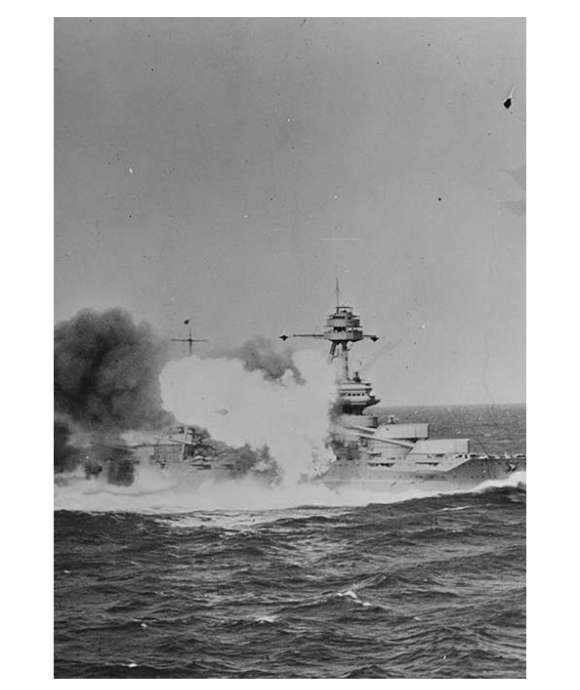
Come On TEXAS! Surviving the Battle for Okinawa
During the battle for Okinawa, the crew of the USS Texas spent over 50 days confined to battle stations in gun turrets and compartments deep within the ship. They stayed put, and saved lives.
Kali Martin
Kali Martin is a former Research Historian of The National WWII Museum's Jenny Craig Institute for the Study of War and Democracy.
Cite this article:
MLA Citation:
APA Citation:
Chicago Style Citation:
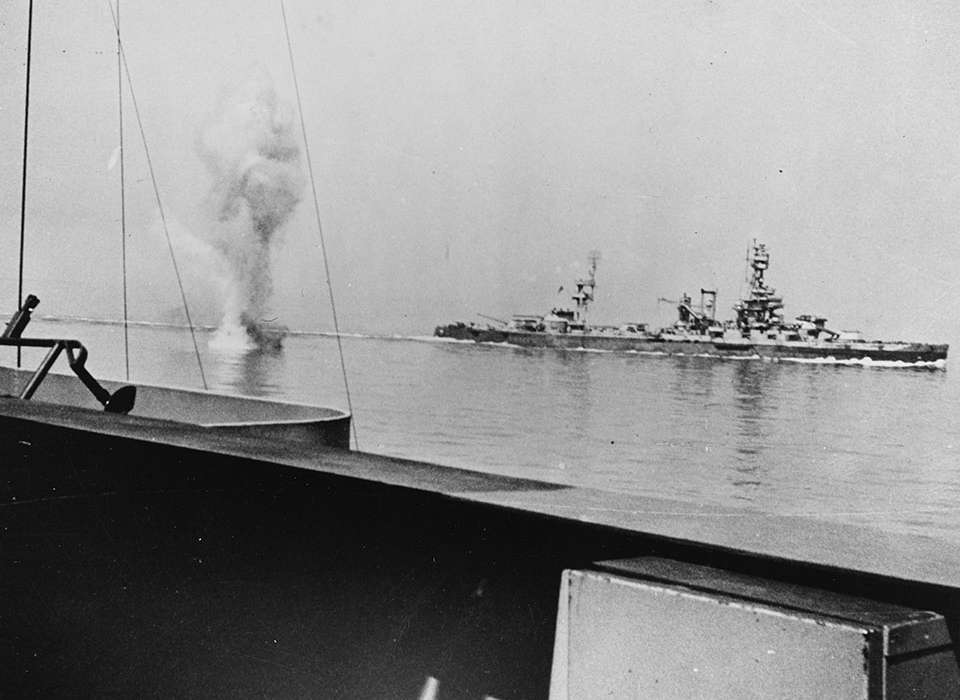


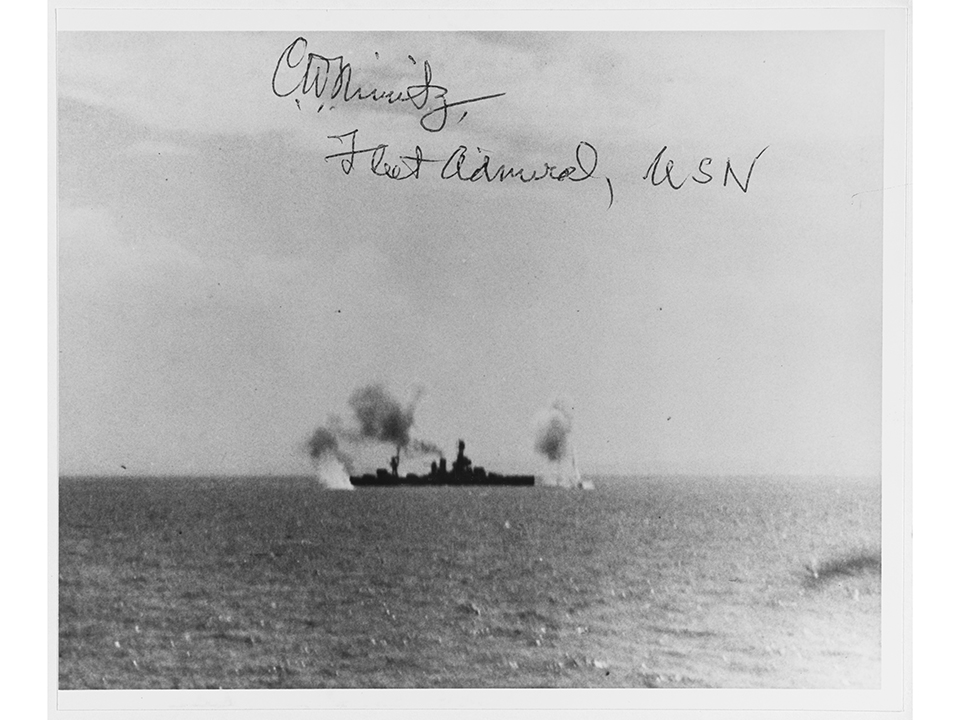
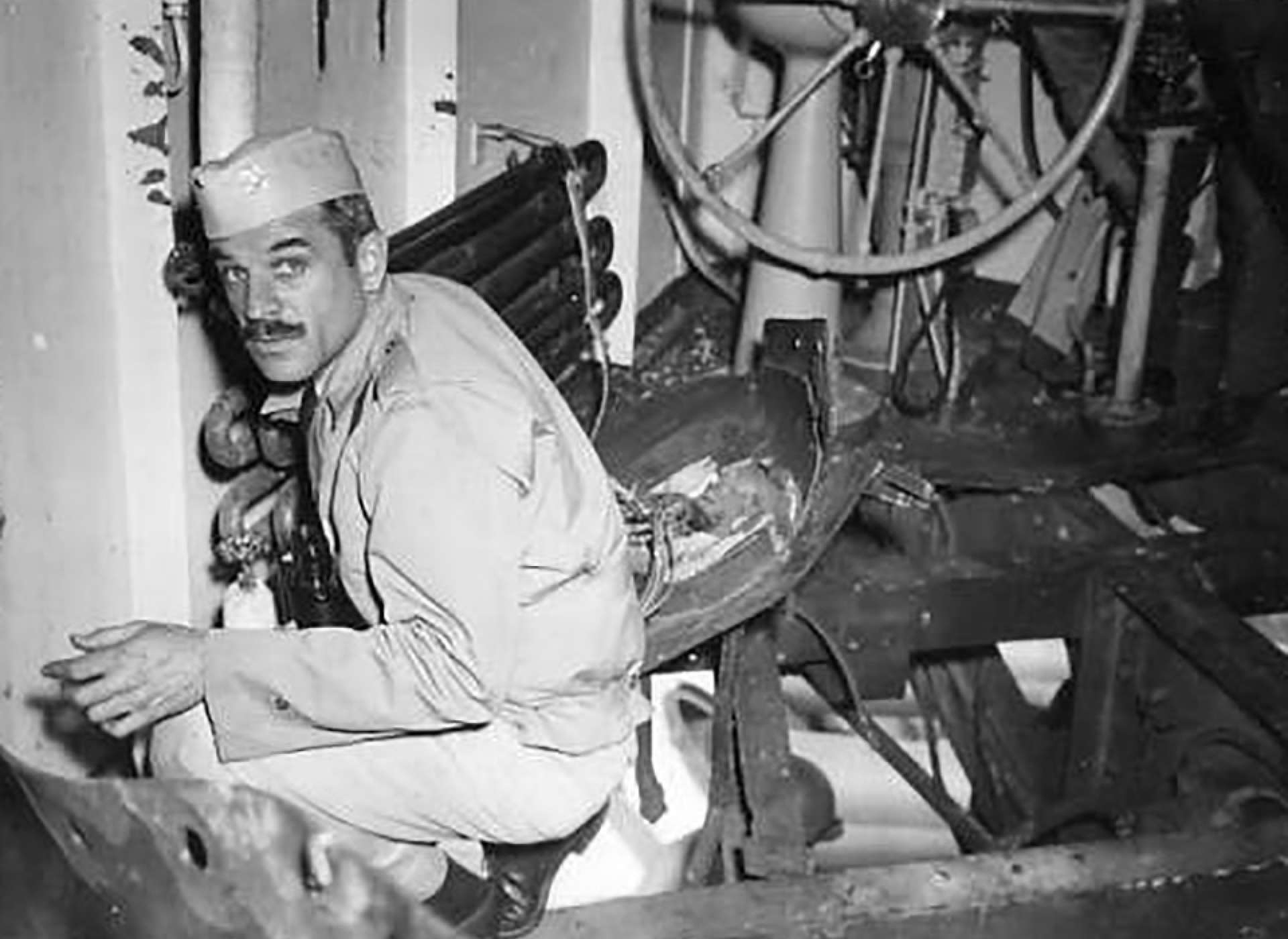
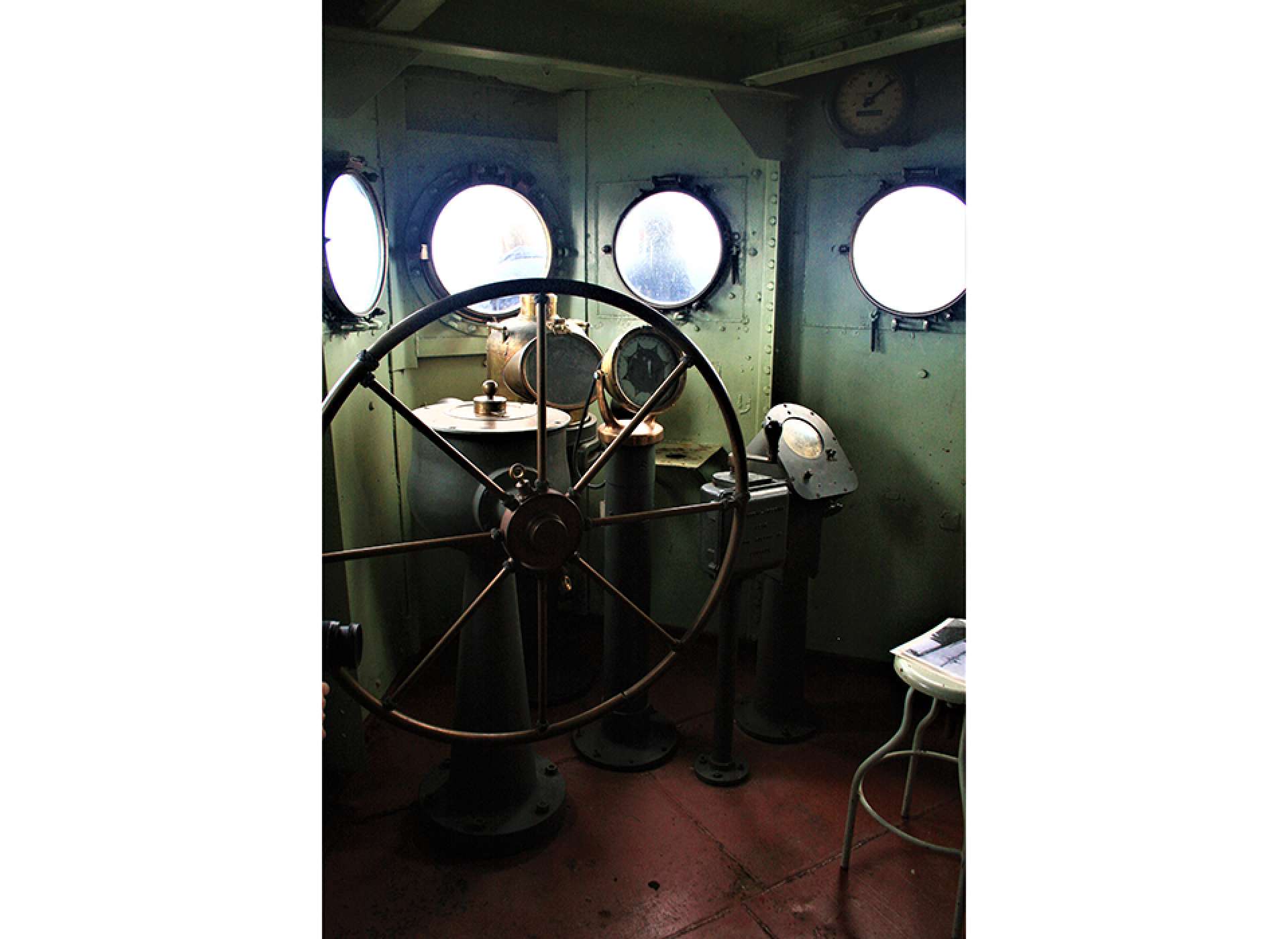
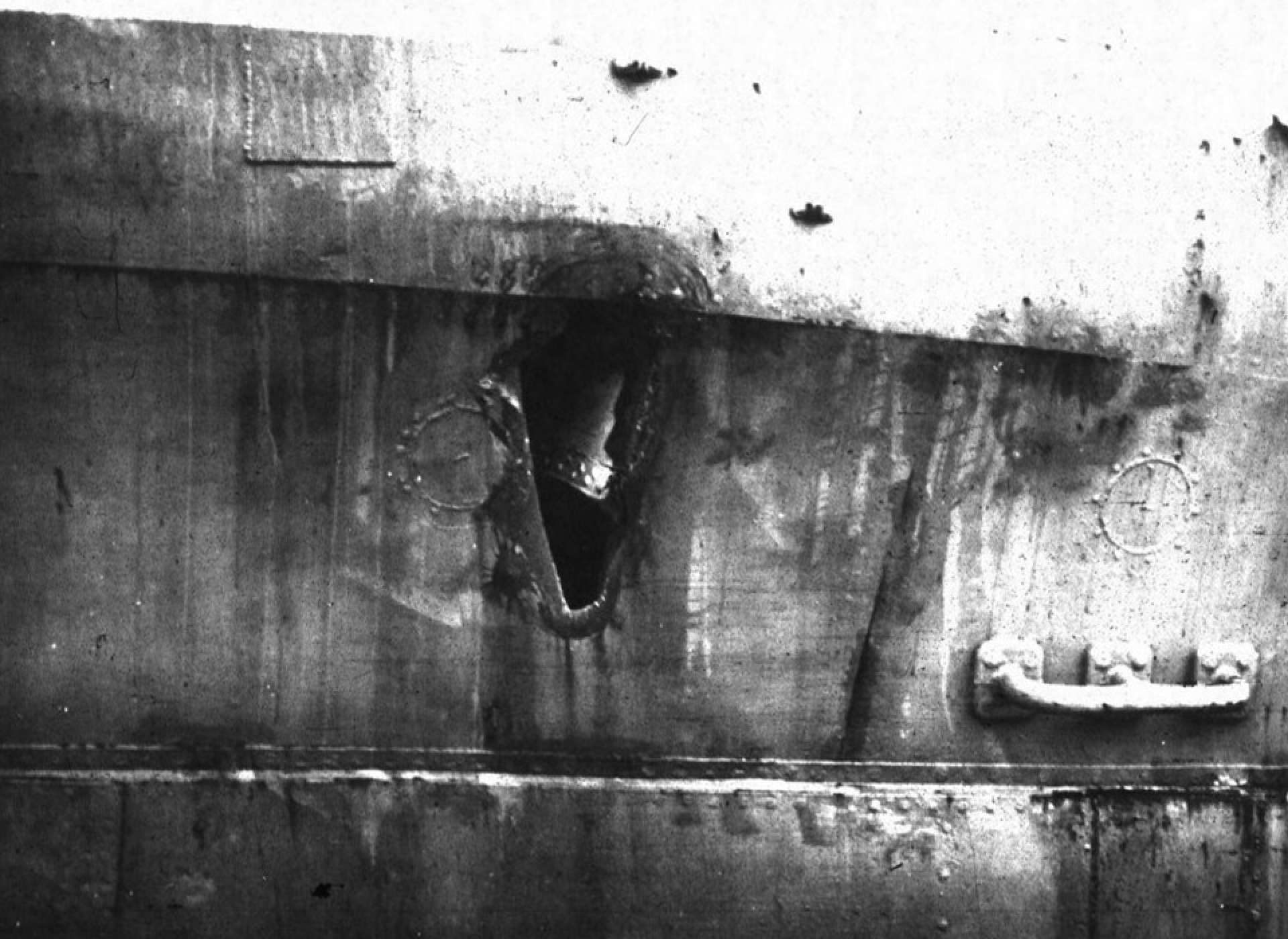
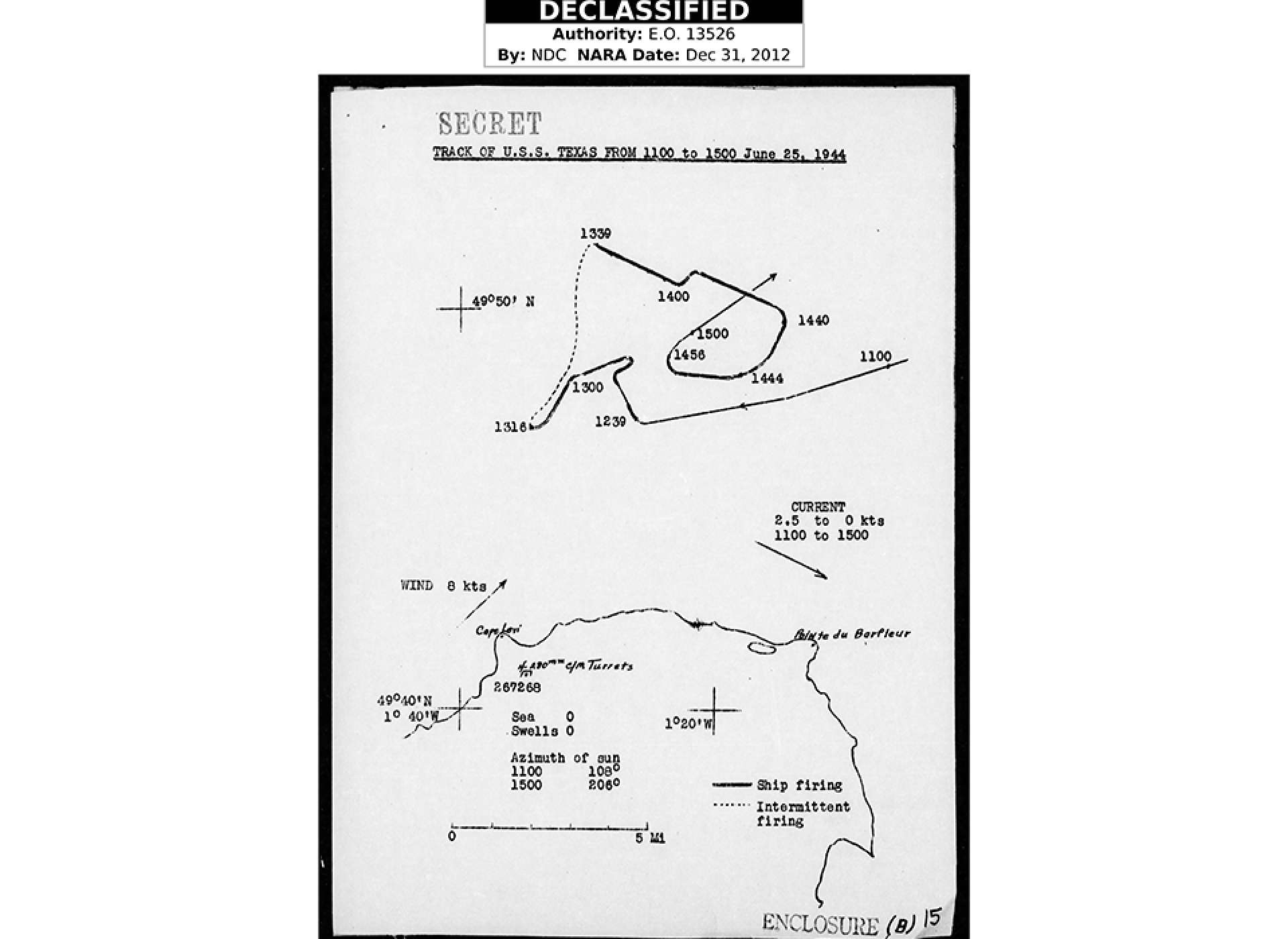
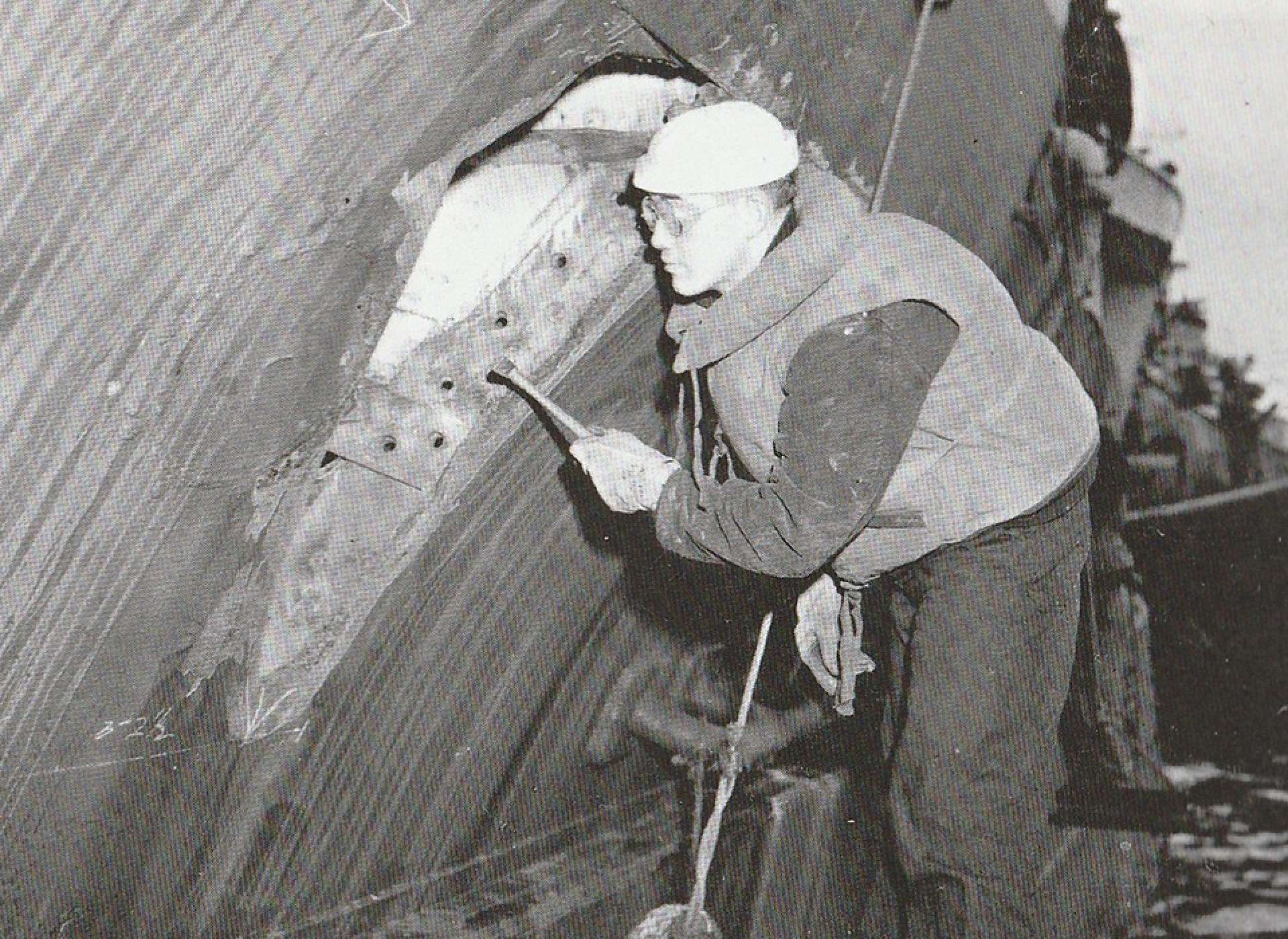
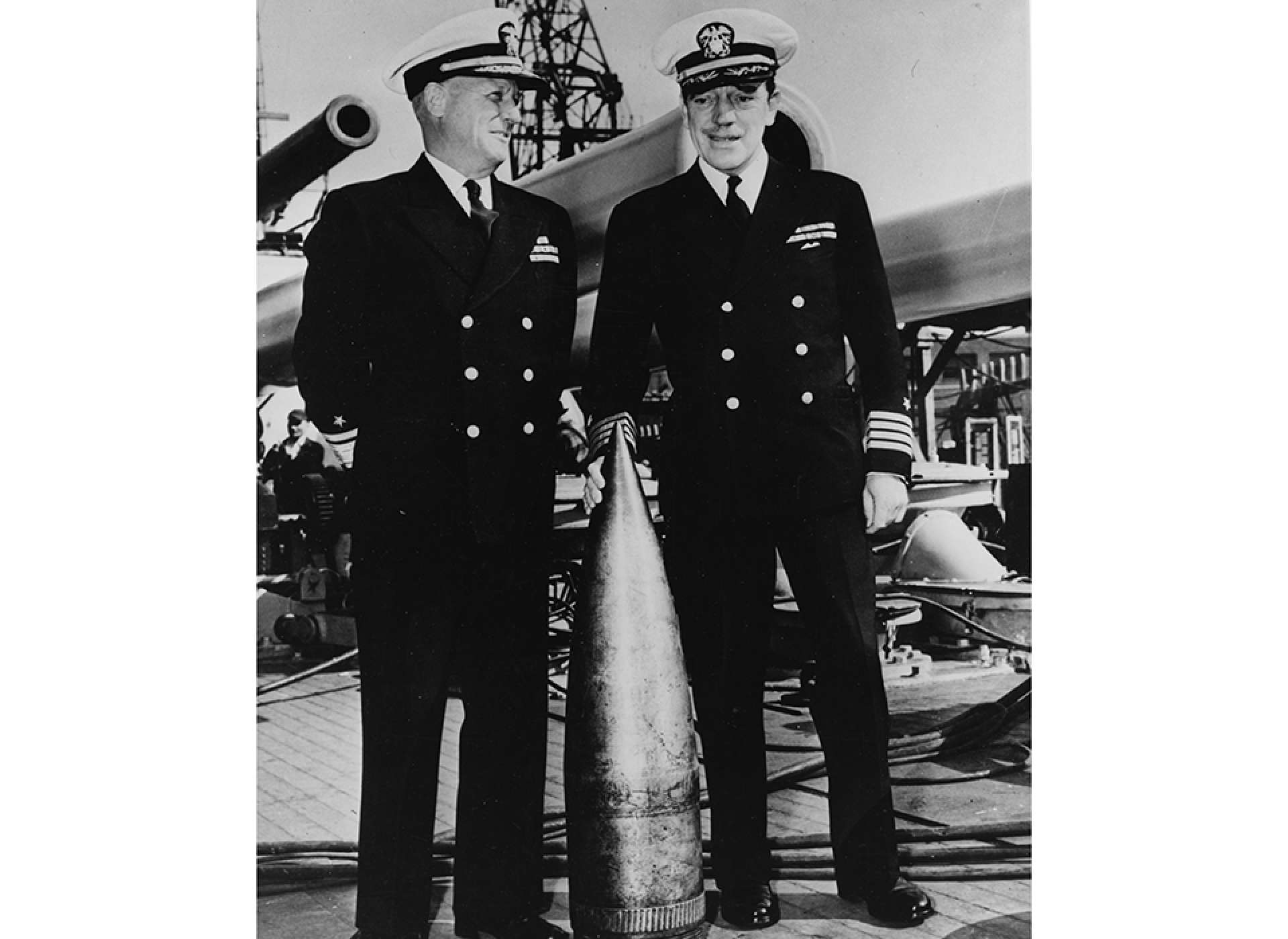




![Max Fuchs, New York City cantor, sings as Rabbi Sydney [sic] Lefkowitz, Richmond, VA, conducts the first Jewish services from Germany.](/sites/default/files/styles/max_650x650/public/2025-10/image1.jpg)



